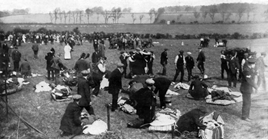One hundred years ago, the worst rail disaster in British history claimed more than 200 lives within a matter of minutes.
In the spring of 1915, the Allied Mediterranean Expeditionary Force had suffered tens of thousands of casualties as it attempted to destroy Ottoman positions after landing at Gallipoli.
On May 22, a special troop train of 21 carriages left Larbert in Stirlingshire, with 498 officers and men of the 1/7th battalion the Royal Scots and the 8th battalion the Highland Light Infantry on board. The men were bound for Liverpool and thence to Gallipoli, to reinforce the losses after a series of failed attacks.
Tragically, of those on board, 216 would never get further south than Dumfriesshire.
At 0630, a slow train from Carlisle arrived on the Down Main and was held at Quintinshill box. The signalman on duty, signalman George Meakin, shunted the train onto the Up Main to allow a later Down express to pass. A train of coal wagons was already parked in the Down loop.
His relief, signalman James Tinsley, jumped off the locomotive to start his day’s work. Meakin briefed Tinsley on the situation, and took his colleague’s arrival as an opportunity to read a newspaper.
As Tinsley went about sorting out his train register, and setting signals and block instruments, the southbound troop train slammed into the parked slow service, propelling it back several yards. The troop train telescoped, and its wooden carriage bodies splintered.
The men in the box reacted with horror, as there was a Down express already heading into their section. Meakin said: “Oh Jimmy, what have you done?” as Tinsley answered a call from the next box down.
“We’ve had a smash up here” was his response to the signalman, before hanging up.
The guard of the troop special and the slow train’s crew tried to flag down the express train. Its driver saw them a few hundred yards from the wreckage, and applied his brakes. But less than a minute later, it ‘clipped’ the troop train, derailing several of its own carriages and tragically running over several soldiers who had escaped the first crash.
Gas used for lighting the trains began to burn ferociously. The driver of the express was buried up to his neck in coal and had to be dug out. The coal train was moved as far away as possible to avoid further conflagrations.
The troops who had managed to get clear from the wreckage worked furiously with tools from the trains to rescue their trapped comrades and other passengers. Local fields were turned into makeshift casualty stations, with survivors and farm workers tending to wounded passengers. The sun was shining, and it was a warm summer’s day. One Royal Scotsman commented in Carlisle hospital later that “we could not have had a better day for it”.
The Caledonian Railway (operator of the troop train and the passenger train, and the employer of the two Quintinshill signalmen) was made aware of the crash as quickly as possible, and by 0714 the railway authorities at Carlisle knew something terrible had happened.
The fire brigade arrived from Carlisle at about 1100 to find dozens of carriages and coal wagons ablaze. Their hoses were useless, and the tenders of the locomotives were either too damaged or too far away to be of use.
The fire cremated dozens of those on board, and made identification of some of the victims impossible - remember this is before detailed dental records and modern forensic examination. Grimly vague identification reveals the extent of the damage to some of the bodies - for example, “three trunks, probably children”.














Login to comment
Comments
No comments have been made yet.